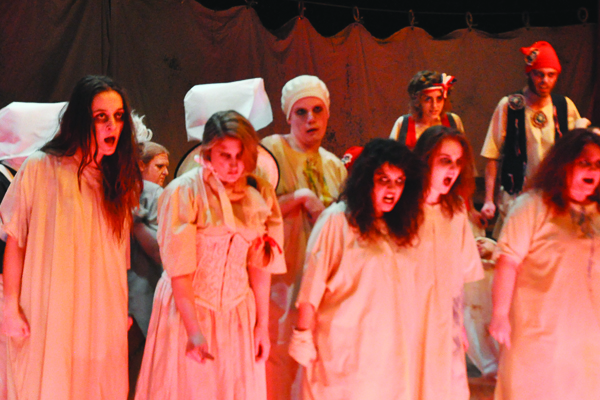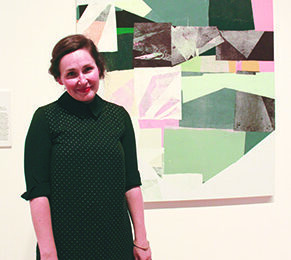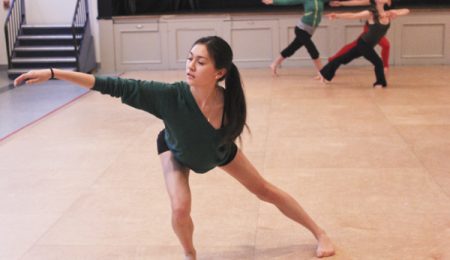Revolution in the asylum
Photo: SabrinaThe audience waits outside the theatre. The entranceway in Séraphin-Marion Private is lit red, white, and blue in support of France, not the United States.
Coulmier, the director of the Charenton Asylum, stands at a podium wearing a white lab coat, and welcomes them to the play, noting his modern mental health treatment methods.
Asylum patients, nurses, and guards stand waiting on stage, with various tics and shuffling movements, often looking directly out at the audience members filling the theatre. Jean-Paul Marat sits in a bathtub, the band sits behind bars, and the guards carry clubs.
The patients are dressed in tattered and dirty, white clothing, with some red and blue accents. Coulmier and his wife, dressed in more fashionable and colourful clothing, sit at the front on one side facing the stage, while the Marquis de Sade, writer and director of the play, and a patient at the asylum, sits on the other side. The audience is in Charenton.
The Persecution and Assassination of Jean-Paul Marat as Performed by the Inmates of the Asylum Charenton Under the Direction of the Marquis de Sade—frequently shortened to Marat/Sade—is a play-within-a-play written in the 1960s by German playwright Peter Weiss. The University of Ottawa performance, put on by the Unicorn Theatre from Feb. 24–28, was directed by James Richardson, a master of fine arts candidate in the department of theatre.
Marat/Sade is set in 1808, taking artistic liberties with the fact that Sade wrote and directed plays while committed to the Charenton Asylum late in his life. It follows the lead-up to Charlotte Corday’s murder of Marat, and is broken up by philosophical debates between Sade and Marat on the nature and purpose of revolution. The patients speak the words of the revolutionaries, some written into the play and some of their own accord, and their quickness to violence seems always on the edge of their own revolution.
The performance featured a cast of more than 25 on stage together, each character with their own mannerisms, afflictions, and movements. The actors portrayed these consistently, giving each patient a personality the audience could recognize throughout.
During the performance, actors would look out from stage, appearing to stare at one person, breaking the traditional fourth wall between actor and audience. Being acknowledged was discomfiting.
The band played music that at times sounded intentionally discordant but appropriate.
At times, the quirks and outbursts of the patients took attention away from the main action. However, the distractions served a function. The tension in the play pointed to the historical tension between the dominant narratives of the revolutionary leaders like Marat, and the experiences of the many people he was meant to represent.
Paul Piekoszewski as Sade was a believable French aristocrat trying to make sense of what had happened 15 years earlier by debating a ghost figure and giving the patients a channel to voice their views. Jérémie Cyr-Cooke cast as a patient playing Marat was a passionate focal point for the action on stage, sitting in his bathtub. Each member of the cast was strong, and everyone reacted to each action on stage naturally and in keeping with their character. Any one of them seemed able to step in as lead.
The play is rich with characters that feel like real people, voicing opinions that are not locked up because they are in an asylum or because they are based on the not-so-distant past.
In the play, Coulmier watches the play along with the audience for a reason. He objects that some lines and scenes are unsuitable because they portray things from the past that are now irrelevant—they live in the enlightened, post-revolutionary future. Why dredge up all this unrest? We may lock up those things and people we consider undesirable, but they are still there.







